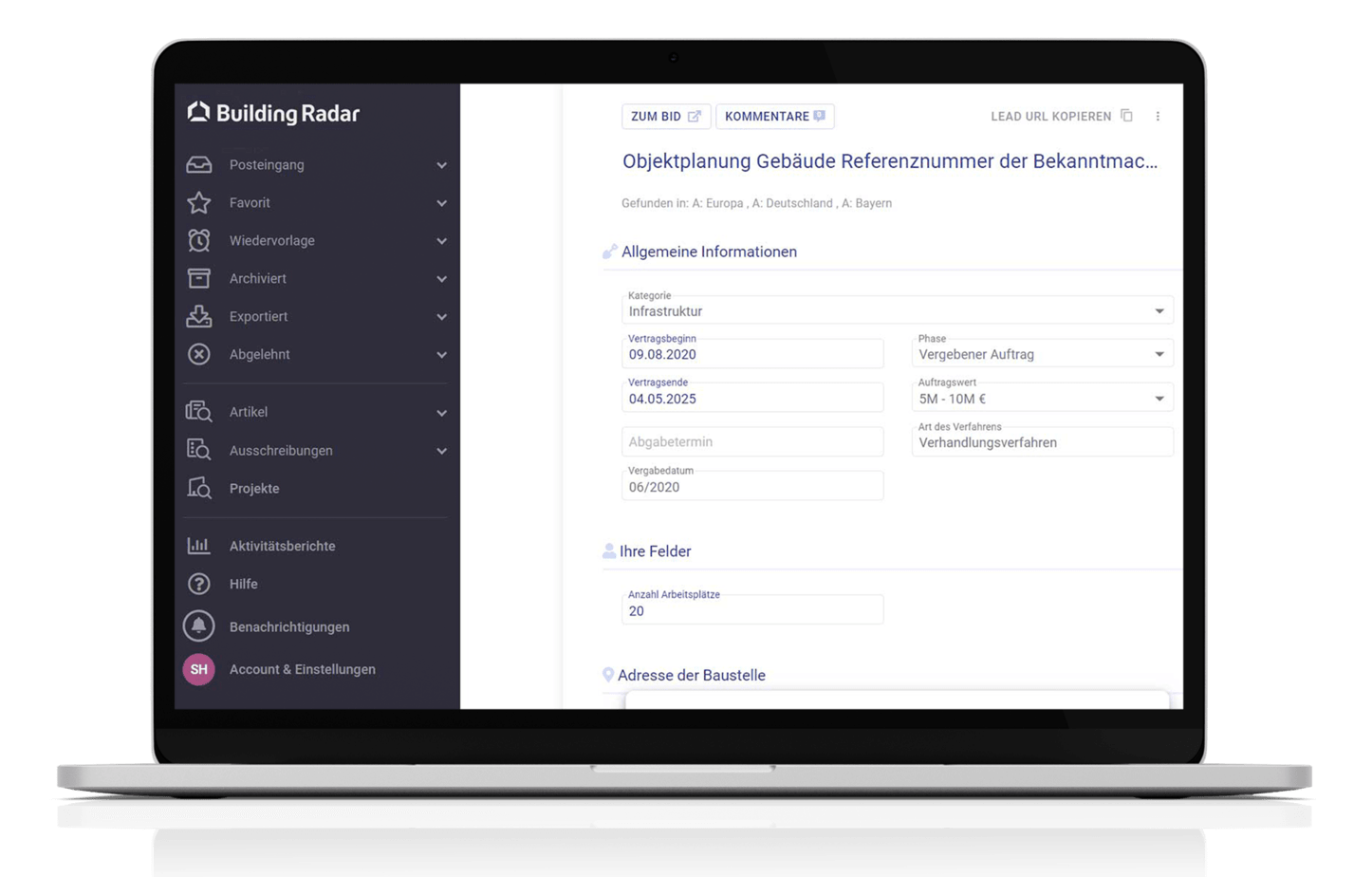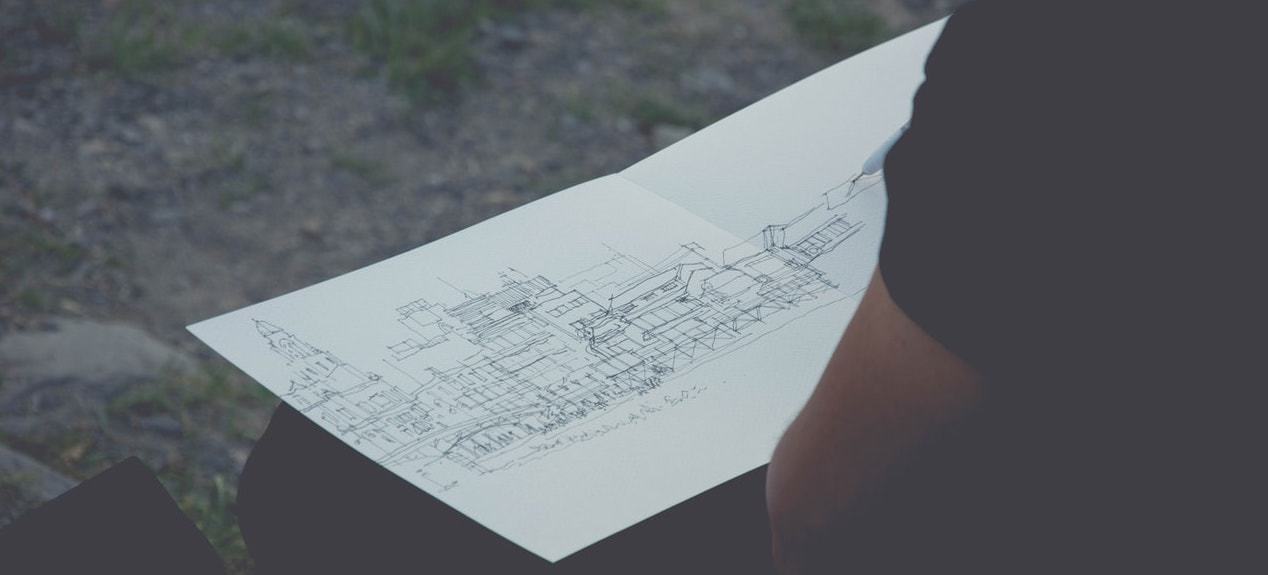Architect: “Unfortunately we are already in contact with one of your competitors, but will keep you in mind for our next project.”
The next project of the architect does not meet with your line of business, and thus you sink into oblivion. If you know this situation, you probably have chosen the wrong time to contact!
1. Basic determination
2. Preliminary Planning
3. Design Planning
4. Execution Planning Phase
5. Preparation of the awarding procedure
6. Participation in the award
7. Object monitoring
8. Property support
Your sales team needs to know the different workflow stages of an architect. Only if your sales team has enough background information about the working progress of an architect, they can choose the right time to contact. Use this article as a refresher, so that you can choose the right time to reach out to the architect!
1. Basic determination
The first step includes the evaluation of the ideas and requirements for the project. Also, the discussion of the timeframe and different construction phases happen during this time.
This first construction phase starts with the evaluation of fundamental questions. Where is the project going to be located? When is the start of the early construction work? What is the usage of the building? Also, the architect supports the builder with the inspection of locations that are under consideration. As soon as the financing plan is clarified, the discussion about the further course of the construction phases starts.
The most important tasks of the architect during the phase of basic determination are:
- Clarification of the task based on the ideas and requirements of the client
- Accompaniment for a site visit
- Providing general advises
- Support during for the selection of specialist manufactures
- Summary, explanation, and documentation of the results
2. Preliminary Planning
After the approvement of the financial plan, the preliminary planning is carried out as the next step of the construction progress. The architect creates a draft concept and estimates the costs. Just a few years ago, plans were still drawn by hand. Meanwhile, Software like CAD or BIM is used to bring preliminary drafts to life. As a result, the architect can directly integrate participating authorities (e.g., building regulation office and city planning office) for a faster and easier approvement of the construction project. Details do not matter here. It is about the first clarification of design and function, questions of construction technology and building physics, economic efficiency, energy supply, and ecology.
The most important tasks of the architect during the preliminary planning are:
- Coordination of the specialist planners
- Preparation of preliminary planning, investigation, and presentation of requirements
- A scale drawing of the object
- Compilation of the previous work results as a basis for the other specialist planners
- Initial negotiation on the approval ability
- Cost estimation and comparison with the financial conditions
- Creation of a schedule with the essential processes of the planning and construction process
| Project participants during this phase: Structural engineers, house technicians, landscape or interior designers |
3. Design Planning
As soon as the client has approved the cost estimate, further coordination of the preliminary draft starts. Now the model is completely planned: graphically and virtually. This third phase is the time to start to include factors like urban requirements, economic and social factors as well as legal requirements.
The most important tasks of the architect during the design planning phase are:
- Compilation of work results as a basis for the participating planners
- Creation of an object description
- Negotiation on the approval ability
- Cost calculation and comparison with the cost estimate and the financial possibilities
- Summary, explanation, and documentation of the results
- Establishment of a detailed cost estimate by trades
| Project participants in this phase: Planner for fire protection systems, monument authorities, nature conservation or public order. |
4. Execution Planning Phase
The approval planning procedure smoothly ties up with the results of the previous phases. The process of requesting the legal approvement from the public authorities begins. The architect uses the summarized information to create the application documents that are required by the building authorities.
The architect further elaborates the results of the previous designs in close collaboration with specialist planners. The calculation of the required quantities of building material is now getting underway (mass determination).
Based on this data, the architect discusses with the client details such as the type of lighting or the number and positions of the outlets. And finally, these quantities are the basis for the preparation of the offer documents. Usually, the contracted manufacturers are already involved in a consultive role. Together with the specialist planners, the architect creates a detailed object description. These documents ultimately form the basis for the work of artisans and specialist firms.
The most important tasks of the architect during the approval planning phase are:
- Negotiation about the approvement of the construction project with the neighbors
- Creation of corresponding verifications (technical, constructive and building physics)
- Submission of documents
- Supplementing and adapting the planning documents, descriptions and calculations
- Implementation planning
| Project participants in this phase: structural engineers, interior designers, kitchen planners, designers for heating and sanitary installations, specialist planners for fire protection systems (sprinklers), ventilation systems, landscape architects … |
5. Preparation of the awarding procedure
In this construction phase, the contracts for the manufacture companies are going to be prepared. All tender documents are compiled, talks with specialists construction companies are held, and cost estimates are obtained. The trades are divided into different sections. For example, roofing works may include roof covering work and roof insulation work. The architect also prepares the necessary contracts with specialist companies.
The most important tasks of the architect during the preparation of the award are:
- Establishment of an appointment schedule
- Preparation of service descriptions
- Determination and composition of quantities
- Cost control by comparison of the performance specifications priced by the planner with the cost calculation
- Compilation of the tender documents for all service areas
6. Participation in the award
The building material quantities determined during the execution planning are summarized by the architect in bills of quantities (offer documents). These specifications are finally sent to the companies of the individual trades. Bills of quantities are offer documents in which suppliers enter their prices for the personal items. Because all invited providers receive the same offer documents, a direct comparison of offers is possible without restrictions. The architect creates a list of companies whose offers are interesting to obtain. At a given time, the completed offer documents are returned to the architect. He checks and evaluates the offers.
The most important tasks of the architect during the execution planning phase are:
- Coordination of the awards
- Obtaining offers
- Review and evaluation of offers including setting a price level and reviewing offers of additional services
- Leading bidders
- Documentation of the award procedure
- Compiling the contract documents for all service areas
7. Object monitoring
This construction phase represents the most extensive task for the architect. First, a construction schedule is created. This plan describes the requested time slot of the executing companies and their dependencies on each other. Also, the completion date is set. According to this schedule, the architect assigns the companies and controls their results. The architect supervises the execution of the work and checks the conformity with the building permit. The architect also double check the bills of the manufactures and renegotiates in case of discrepancies. After completion of a construction work section, the architect takes the construction work, taking into account any defects and remaining work.
The most important tasks of the architect during the execution planning are:
- Coordination of object monitoring
- Documentation of the construction process
- cost control
- Cost determination
- Detection of defects
- List of limitation periods for claims for defects
- Monitoring the elimination of identified deficiencies
8. Property support
The property support in the construction industry has nothing to do with site management or construction supervision. This phase includes an inspection of the construction project after completion of the structure for determining the defect.
The most important tasks of the architect during the property support phase are:
- Evaluation of the deficiencies found
- Inspection of defects
- Monitoring the removal of defects
- List of equipment and inventory directories
- Creation of maintenance and care instructions
- Creation of a maintenance concept
- Object watch
| Visit our construction industry blog to get further tips how to get specified by architects |

Easily find just the right early stage construction leads!
The fastest construction lead technology worldwide.











